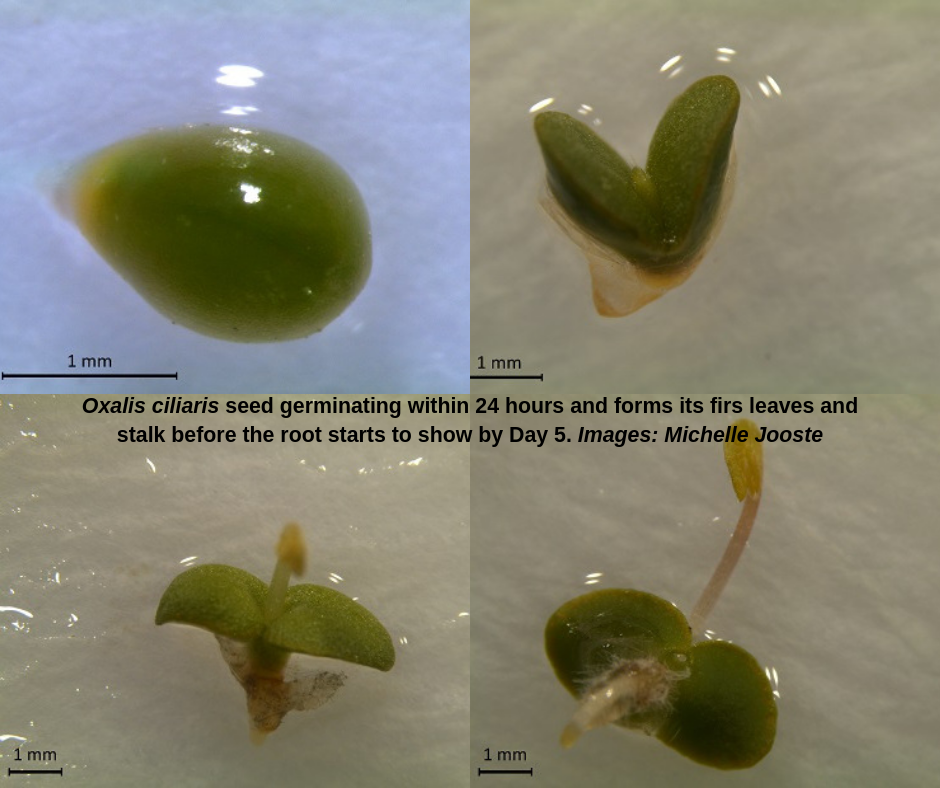Over the past 15 million years South Africa's common wood sorrel has developed an arsenal of the most unique and extreme germination strategies in the Cape Flora.
Yet the same strategies that have allowed these delicate little plants to grow and survive in the most uninhabitable places thinkable – think of the Richtersveld, Knersvlakte, Oorlogskloof and Gifberg – may now be to its detriment under a fast changing climate.
In a study published in the American Journal of Botany recently, Dr Michelle Jooste from the Department of Botany and Zoology at Stellenbosch University describes a continuum of germination states for 64 species of Oxalis: from germinating within 24 hours (called recalcitrant seeds) to lying dormant for several years, while waiting for the ideal environmental conditions to germinate (called orthodox seeds).
Prof Léanne Dreyer, one of the co-authors and a leading expert on southern African Oxalis, says the wood sorrel's germination strategies are nothing short of weird, extreme and unique in the plant kingdom.
“Oxalis had to adapt to a Mediterranean climate subjected to long hot and dry summers alternating with a very predictable wet winter rainfall season. Dealing with these two extremes, which have remained stable for the past 15 million years, enabled Oxalis to take germination strategies to a whole new level," she explains.
Even more unique is the incidence of inverse germination in some Oxalis species, where the seed leaves and the first foliar leaf develop rapidly and appear to sustain rapid growth of the seedling before the radicle and root hairs subsequently emerge.
“This is a remarkable phenomenon," says Dreyer, “and it is happening at the speed of light, as the plant needs to have enough time and produce sufficient resources within a single growing season to also form a bulb in order to survive underground during the hot, dry summer months."

But it doesn't end here. The researchers have noticed that some of the recalcitrant species produce large amounts of a thick gluey substance (called mucilage) upon germination. They are now investigating the presence of bacteria in the mucilage, which appear to be symbiotically associated with these seeds – a symbiosis is when two or more organisms live together in a close mutually beneficial association.
Even more extreme are those Oxalis species of which the seeds are capable of either rapid germination or staying dormant: “These seeds have the benefit of immediate germination if environmental conditions are favorable, or to delay germination until conditions become more favorable," Dreyer explains.
These types of seeds are extremely rare. In the case of Oxalis, only 19% of the 64 species studied – selected to be as representative as possible of the nearly 230 known southern African Oxalis species – displayed intermediate germination.
Intermediate and recalcitrant species (56%) are almost exclusively restricted to the winter rainfall areas of the Cape, while orthodox species (24%) are present in both summer and winter rainfall areas.
Dreyer says they regard the orthodox strategy as the ancestral state among Oxalis species. The big question now is whether Oxalis has one more survival strategy in its arsenal to deal with drier conditions and a less predictable winter rainfall in the Cape Floristic Region as predicted by models of future climate change.
“If not, we stand to lose more than 50% of Cape Oxalis species – that is more than 115 species!" she concludes.
On the photo above, within 24 hours, a day-old seedling of Oxalis gracilis with opened seed leaves between which the first foliar leaf is starting to develop. Note that the radicle is still completely underdeveloped, and the seedling is imbedded in a mucilage. Image: Léanne Dreyer
Media enquiries
Prof Léanne Dreyer
Department of Botany and Zoology, Stellenbosch University
Tel: +27 _21 808 3070
E-mail: ld@sun.ac.za

